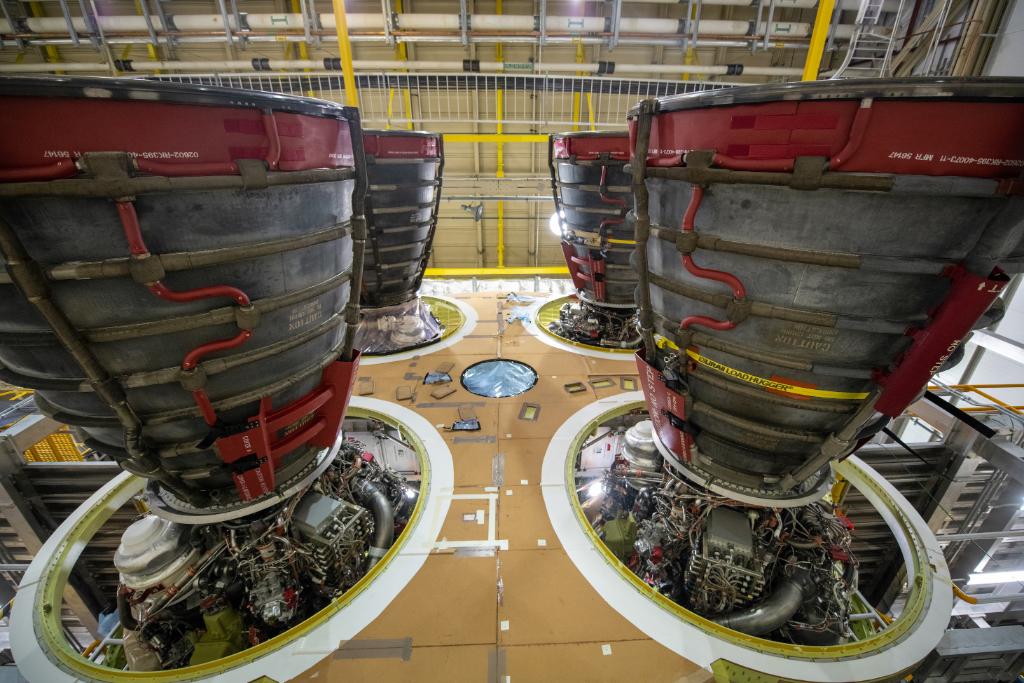NASA orders 18 more engines for its Space Launch System megarocket

NASA has ordered 18 more rocket engines for its new Space Launch System megarocket for future Artemis moon missions.
The new order, valued at $1.79 billion, calls for the California-based aerospace company Aerojet Rocketdyne to provide 18 RS-25 engines to power future SLS rockets. The agreement builds upon an existing deal between NASA and Aerojet for six SLS engines. This new order boosts the final contract's value to about $3.5 billion through 2029, NASA officials said.
"This contract allows NASA to work with Aerojet Rocketdyne to build the rocket engines needed for future missions," NASA SLS program manager John Honeycutt at the agency's Marshall Space Flight Center in Huntsville, Alabama said in a statement.
Related: How NASA's Space Launch System will work (infographic)
Each SLS rocket will use four RS-25 rocket engines to launch its 212-foot (65-meter) core stage. The rocket will also use two strap-on solid rocket boosters and an upper stage to launch NASA's Orion crew capsule. The Artemis program will use SLS and Orion to return astronauts to the moon by 2024.
NASA currently has 16 of the engines (salvaged from the agency's now-retired space shuttle program) that will be used on the first four SLS rocket launches for Artemis missions 1 through 4. Those engines will cover Artemis flights through the program's first crewed moon landing (Artemis 3) and a follow-up flight.
NASA's Artemis 1 mission is expected to launch in 2021. The engines for that flight are installed on an SLS core stage and awaiting a major test at NASA's Stennis Space Center in Mississippi. That work has been on hold since March due to the ongoing coronavirus pandemic.
Breaking space news, the latest updates on rocket launches, skywatching events and more!
The new agreement with Aerojet Rocketdyne will add another 24 SLS engines for the Artemis program, enough for another six flights.
"We've already begun production on the first six new RS-25 engines," SLS engines manager Johnny Heflin said in the same statement. "Aerojet Rocketdyne has restarted the production lines, established a supplier base and is building engines using advanced techniques that reduce both the cost and time for manufacturing each engine."
The SLS rocket's four RS-25 engines provide a total of 2 million lbs. of thrust during launch to carry an Orion capsule into orbit. The engines left over from the space shuttle program have been overhauled with new computer controllers and upgraded to ensure they can handle the higher performance demands of an SLS launch, NASA officials have said.
- Watch NASA's SLS megarocket get ready for new US moon missions (video)
- NASA needs to put a price on Artemis to gain support from Congress
- Europa mission shouldn't be shackled to SLS megarocket, NASA OIG says
Email Tariq Malik at tmalik@space.com or follow him @tariqjmalik. Follow us @Spacedotcom, Facebook and Instagram.
OFFER: Save 45% on 'All About Space' 'How it Works' and 'All About History'!
For a limited time, you can take out a digital subscription to any of our best-selling science magazines for just $2.38 per month, or 45% off the standard price for the first three months.

Tariq is the award-winning Editor-in-Chief of Space.com and joined the team in 2001. He covers human spaceflight, as well as skywatching and entertainment. He became Space.com's Editor-in-Chief in 2019. Before joining Space.com, Tariq was a staff reporter for The Los Angeles Times covering education and city beats in La Habra, Fullerton and Huntington Beach. He's a recipient of the 2022 Harry Kolcum Award for excellence in space reporting and the 2025 Space Pioneer Award from the National Space Society. He is an Eagle Scout and Space Camp alum with journalism degrees from the USC and NYU. You can find Tariq at Space.com and as the co-host to the This Week In Space podcast on the TWiT network. To see his latest project, you can follow Tariq on Twitter @tariqjmalik.

